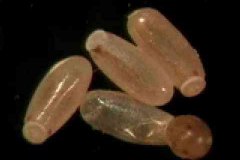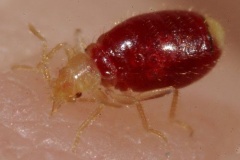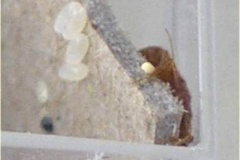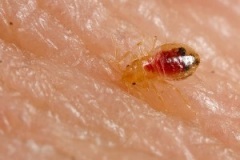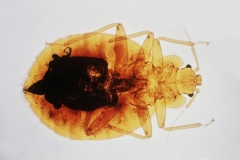This article by Jerry Cates, first published on 18 August 2013, was last revised on 23 September 2015. Bugsinthenews Vol. 14:08(01).
001. Mature Bed Bug from Northwest Austin, Ventral View
002. Mature Bed Bug from Northwest Austin, Dorsal View
The Early History of Bed Bugs
Unlike the case for most other organisms, whose scientific names were assigned by the scientists who first described them, the label for the common bed bug (Cimex lectularius) was given by the folk who suffered from its bites. They named this insect based on their understanding of the beast itself and the places it tended to haunt.
The Latin word for bug is cimex. Latin for a small couch, litter, or bed islectus. The inhabitants of the sprawling Roman Empire from the modest huts of the poorest commoners to the opulent bedrooms of the Caesars themselves were all afflicted with infestations of these tiny, blood-hungry insects. Just like us, they talked amongst themselves about their problems, and bed bugs were a serious problem. Any mention of this minuscule, ravenous beast would likely have employed both words, along with a few more colorful adjectives as well.
But bed bugs and their afflictions on mankind preceded ancient Rome. In truth, they preceded written history by thousands of years. Archeological evidence, unearthed in Mediterranean caves, suggests they got their start as bat bugs, feeding on the blood of bats inhabiting those caves and similar locales where bats tended to congregate.
Primitive human hunter-gatherers regularly took up housekeeping (or, more precisely cave keeping) in close proximity with bats, and it wasnt long before bat bugs took to feeding on human blood when bat blood was in short supply. That happened rather frequently, because many species of bats are migratory. When the bats departed for their winter or summer homes, most of their parasitic bat bugs whose legs are not well adapted to clinging to bat skin or fur during long periods aloft would go hungry until they returned, six months or so later. Fortunately, these bugs are able to survive for long periods of time without feeding, but having cave-dwelling humans nearby made fasting unnecessary. How convenient
Over many millennia certain of the bat bugs came to prefer human hosts to bats. In time they developed anatomical characters that sharpened their preference for humans and other terrestrial animals, though even today bat bugs and bed bugs are capable of feeding on bats and humans when their preferred hosts are not close by. When cave-dwelling humans became more numerous, and transitioned from caves into loose aggregations of houses and huts, their newfound parasites came along for the ride. There, in the bedrooms of villages, towns, and cities, the accommodations were even better suited for bed bugs to thrive. As mankind continued to move into new and unexplored territories, the bed bugs traveled with them, eventually reaching every corner of the globe that man marched into.
As chronicled by my old friend, Michael Potter, in his excellent paper onthe history of bed bugs, these pests are believed to have reached Italy in 77 C.E. They arrived in China by 600 C.E., and got to Germany and France in the 11th and 13th centuries. They were not reported in England until 1583, but by the 17th and 18th centuries were quite common among the Limeys.
The Americas were different. None of the indigenous American tribes have words in their languages that refer to these pests, suggesting they were not afflicted by them before the first European settlers arrived. When ships from Europe sailed into the natural harbors of the New World, they often brought bed bugs with them. Ships, it so happened, provided perfect habitats in which bed bugs may propagate. Soon native Americans began to feel the bite of the bed bug, along with the rest of the world.
Potter points out, too, that in those days as also is true today the poorest members of society tended to suffer more from bed bug infestations than the rich. This is due, in no small measure, to general deficits in sanitation and the high costs of applying remedial pesticidal measures.
Prior to the 1940s, once bed bugs infested a given locale, they tended to thrive and multiply without respite. There were no economical, sure-fire pesticidal remedies available in those days to combat their spread. Over time practically every possible remedy was tried. Some including highly toxic arsenic, mercury, and cyanide compounds were found effective for bed bug control, but at considerable risk to the human occupants of the treated dwellings. Other effectual remedies included vapor-producing toxins such as high-test gasoline, ethanol, and similar flammables whose use sometimes produced tragic, raging fires. Then came DDT
The Advent of Dichloro-diphenyl trichloroethane (DDT)
DDT was first synthesized in 1874 by Othmar Zeidler, a young Viannese pharmacologist, who was at the time a chemistry student preparing his thesis. He published details of his synthesis, but did not investigate its properties. Thus DDTs utility as a pesticide lay undiscovered for the next 65 years.
Paul Hermann Mller (1899-1965), a Swiss chemist with the Geigy Company, achieved fame in 1937 by patenting a process to synthesize rhodanide/cyanate-based bactericidal and insecticidal compounds. Shortly thereafter he developed Graminone to disinfect seeds without using mercury. These feats led Geigy to finally assign him to a job he had been coveting for some time, developing novel insecticides that would be highly toxic to insects but significantly less toxic to mammals. The most effective, economical pesticides of that period were based on compounds of arsenic, whose indiscriminate toxicities endangered humans and other animals along with the insects against which they were applied.
Mller, no stranger to the search for low-toxicity pesticides, had already come to realize that the absorption of chemicals differed between insects and mammals. He theorized, as early as 1935, that it should be possible to find inexpensive, long-lasting chemicals that were toxic to insects but relatively harmless to humans. Like Thomas Edison, in his ceaseless search for an efficacious filament for his light bulb,Mller began testing every chemical compound that appeared to fit his theorized model. Four years later hed tested as many as 349 chemicals, and every one failed to kill insects. Then, one day in September of 1939, he synthesized Zeidlers compound and smeared a small amount in an enclosure containing a fly. Shortly afterward, the fly expired, and DDT was born.
He subsequently received the Nobel prize in Physiology or Medicine, in 1948. This honor was awarded to Mllerfor, as the official citation asserted, his discovery of the high efficiency of DDT as a contact poison against several arthropods.
100. Mature Bed Bug, showing the insects long, sharpened beak, used to pierce a hosts skin and suck out blood through its straw-like rostrum.
DDTs meteoric Success and cataclysmic Demise
The temptation to launch into a detailed discussion on the miraculous effectiveness of DDT against mosquito-borne diseases such as malaria, typhus, and yellow fever is overwhelming, but I shall albeit reluctantly desist. The storied efficacy of this chemical applied equally to bed bug eradications as well. In fact, by the 1960s, solely due to the widespread use of DDT, bed bugs had been entirely eliminated from every nook and cranny of western Europe and North America, among many other places on the globe. However, DDT was banned for agricultural use in the U.S. in 1972, and later for all other uses in the U.S. as well. The reasons for this are shrouded in controversy, and many in the U.S. pest management industry continue to believe that the case against DDT was flawed and nonsensical.
Scientific evidence, on the other hand, conclusively shows that DDT is a highly persistent organic pollutant that is readily absorbed in soils and sediments, where it is taken up by aquatic organisms. This led to accumulations of DDT in the food web of humans and other animals, and over time unexpected consequences of those accumulations began to surface.
In birds, for example, accumulations of one DDT metabolite, DDE (dichloro-diphenyl-dichloroethylene), caused eggshell thinning. This resulted in dramatic population declines among birds of prey such as condors, bald eagles, hawks, and falcons. In humans DDT is now recognized as a genotoxin and endocrine disrupter. As such it has been linked to increased incidence of diabetes, developmental disorders (particularly in children and adolescents), and thyroid abnormalities, among others.
It cannot be denied that Mller was on the right track. DDT saved a multitude of lives during its thirty-plus years of use. But DDT was not the perfect answer, and in the end its proven demerits which grew more numerous as time passed by finally led to its demise. In truth, though many DDT proponents turn a deaf ear to such facts, had DDT not been banned it would almost certainly have died a natural death within the next two decades. Every insect targeted by this compound had begun, as early as the 1950s, to show unmistakeable signs of acquired, irreversible resistance, requiring higher concentrations of DDT to be used every year to achieve the same effect as the year before.
Post-DDT America
It seemed inevitable, to most entomologists and pest managers, that once DDT was no longer available to treat bed bug infestations, their numbers would rebound throughout the United States. And, of course, that is precisely what happened. The amazing thing is that it took nearly two decades before the anticipated resurgence occurred. By 1995, however, bed bugs were on the rise in Americas largest cities, and since then the scourge of this blood-sucking, cryptic insect has returned to every city in the land.
In Texas, pest managers are today constantly bombarded with requests to treat bed bug infestations in every kind of setting, from low-income public housing and apartment buildings to the most expensive mansions. Many pest managers choose not to respond to such requests, because the treatment regimen required to ensure full control is daunting, labor intensive, and fraught with risks. Risks like overlooking infested areas at the site (which is easy to do) and having to return, again and again, to re-treat a recalcitrant infestation, wondering if the job will be successful this time. Other risks, too, like the possibility of picking up hitch-hiker bed bugs while at an infested site and bringing them back to the office, or to the applicators own home and bedroom.
Treating for bed bugs
Though aware of the serious risks mentioned above, Ive never turned down a bed bug treatment request anywhere in Texas. As might be expected I have encountered a wide variety of interesting bed bug infestations. About 15% of the calls I receive from people who think they have bed bugs turn out to be something else entirely, so I always carry a microscope along, with a box of collection vials in which to store specimens of whatever can be found at the infestation site. My microscope is now fitted with a platform that positions an iPad camera over the lens, so the client can watch with me as the object under the lens comes into focus, and the iPad camera records what it looks like for later review.
A separate article describes some of the organisms that have shown up in such places. Sometimes the actual culprit is never found, not so much because it isnt there as because the client cant wait all day or night for the exhaustive examination needed to find and identify it. That is particularly the case when I am called out late at night, and the client household still has to get some sleep before going to work and school the next morning. Fortunately, even when the causal agent cant be identified right away, a thorough treatment for bed bugs usually clears up the problem, mostly with a single treatment. Of course, there are exceptions to that, too.
I ask my clients to take important, necessary steps in preparation for and in conjunction with my treatment program to ensure it will be successful. With their cooperation, the treatment goes much smoother, and the results are more satisfying for all concerned. As this article expands, I intend to explain some of these steps below, for those who may be interested in learning what they can do to make things easier for the pest manager who comes out to rid them of these pests.
One thing a home owner or apartment resident should not do is attempt to eradicate bed bugs themselves. Expertise in the methods and use of bed bug control products is imperative, because without such expertise the risk of failure is practically 100%. Worse, amateurish efforts to destroy these bugs typically force them deeper into walls, furnishings, and other places. One result is that an inspection afterward, even one lasting several hours, may not turn up specimens of whatever was doing the biting, even though they are still there, deep in the walls where they cannot be seen. This doesnt prevent professionals from eradicating them, but it makes their job more difficult, contributing to confusion over what the culprit was (especially if it turns out later that it wasnt bed bugs after all) and when bed bugs were the cause often leads to sightings of dead or dying bed bugs over a longer period of time, post-treatment, than would otherwise occur. That can be a serious problem, owing to the negative psychological effect of each new sighting, even though they are usually not biting anyone.
Professionals should be able to bring most bed bug infestation under control with a single treatment, provided they are given enough time to do the job right, and provided the area being treated is not too cluttered with a multitude of harborage conditions. Lots of complex furnishings mean lots of hiding places, all of which need to be treated. Follow-up treatments are usually necessary to handle complications from unusual circumstances. In still other cases, even though the initial treatment was successful, the client remains fearful that some remnants of the bed bug infestation remain, and asks for follow-up inspections to help soothe a fevered brow.
Bed bugs make us paranoid. If we are slightly neurotic to begin with (some would ask, Who isnt?), being victimized by a bed bug infestation is sure to push one over the edge. For those teetering on the precipice, my advice is to relax and take heart in the fact that, done correctly by an experienced professional, bed bug eradication can be quick and certain, and even when circumstances prevent eradication on a single visit, one or two more treatments usually manage to bring them under complete control. My experiences prove that, week, after week, after week
Complications to Good Bed Bug Control
I mention, above, that some bed bug treatments are accompanied by unusual circumstances. In truth, every treatment for bed bugs is unique in one way or another. In the material that will soon follow (it will grow slowly as time permits) some of the more novel situations Ive encountered will be described, along with the steps I had to take in order to deal with them. Please stand by for more
Taxonomy:
References:
Feel free to call Jerry at 512-331-1111, or e-mailjerry.cates@bugsinthenews.inforegarding your experiences with, or concerns about, bedbugs. You may also register, log in, and leave a detailed comment in the space provided below.
Like Loading...
Read this article:
Bed Bugs in Texas | Bugs In The News

 Residence
Residence  Location
Location 

